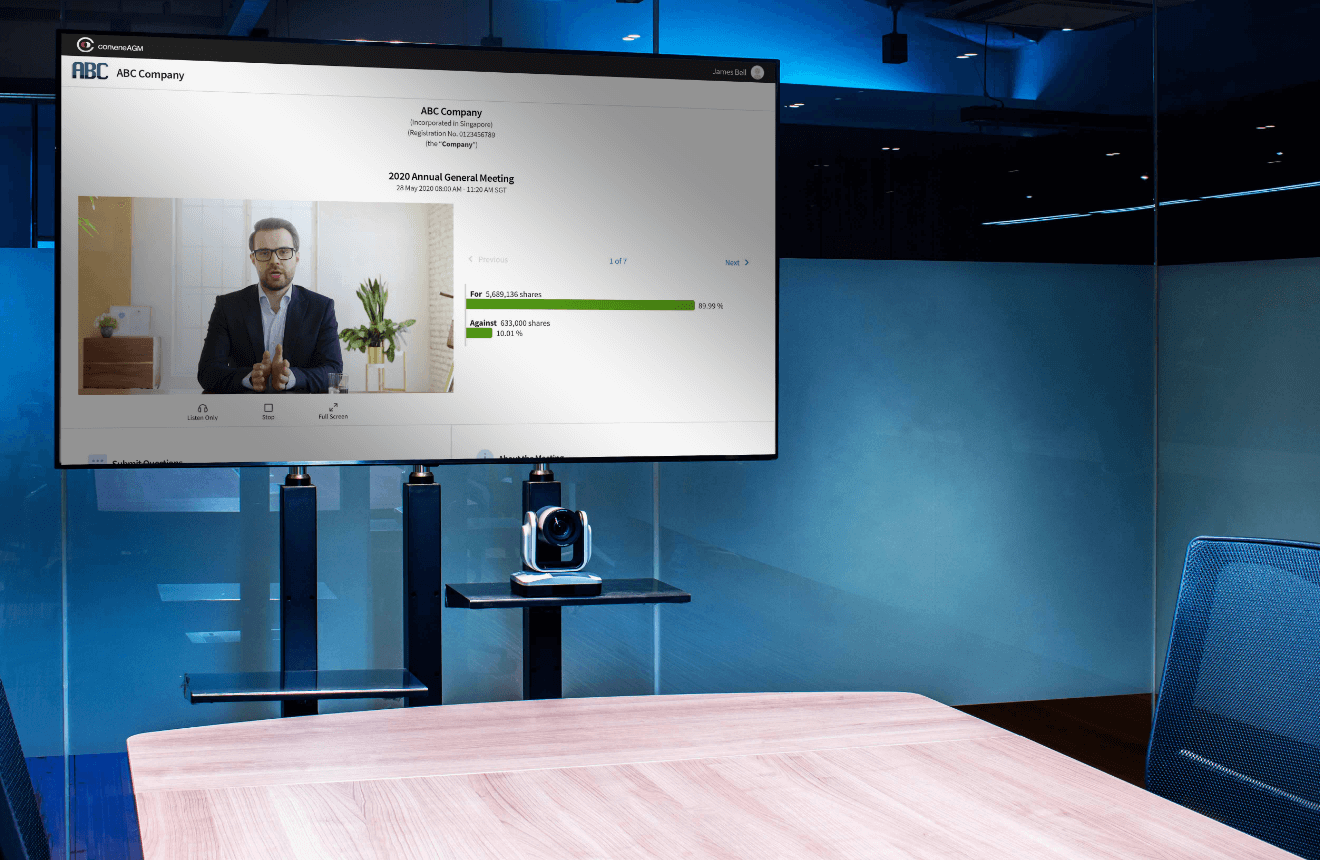Changing times call for changing practices. This explains why company events such as Annual Stockholders Meetings (ASMs) have evolved from physical gatherings to virtual meetings. However, since conducting virtual ASMs in the Philippines is still a relatively new convention, you need to be up-to-date with the best practices to ensure a successful virtual stockholder meeting and raise your corporate governance to the next level.
To conduct the best virtual ASMs, you need to consider three phases – Pre-ASM, ASM Proper, and Post-ASM. It is important to be aware of these phases and what needs to be considered in each stage. This ensures that the organizers can always be in control at any given time and situation and provide a smooth-sailing experience for the participants.
Phase 1 – Pre-ASM
Select the Right Solution. It is essential to understand what your ASM requires in finding the right solution to address anything that could arise from the ASM. Afterward, you may ask your providers if they’re able to manage what your ASM needs. Here is a list of questions to ask a potential service provider when choosing your virtual ASM solution:
- Can the platform support the expected number of users for the meeting?
The ASM solution should be able to accommodate the number of stockholders that will be attending the meeting. So take note of the stockholders and the rest of the attendees from your company who would be overseeing the event.
- Is the security robust?
An ASM is more than just a virtual meeting. Given that the board will talk about sensitive data in ASMs, often involving finances and company plans, you must build the ASM solution with security in mind. The necessary authentication and authorization methods for participants and user access controls on the organizers’ side are musts in any virtual ASM solution.
- Does it have all the features needed for an ASM?
- Registration and Attendance Tracking
- Live Q&A Moderation
- Video Conferencing and Recording
- Live Voting, Voting-in-Absentia, Cumulative voting for elections
Virtual ASMs are expected to work the same way as physical ASMs do, so having features that allow for registration, Q&A, and voting is fundamental to giving stockholders a great experience.
- Is the user interface intuitive for its users?
The platform must be easy enough to understand, even for stockholders who are not tech-savvy. Since they would have checkups after the company presents their first experience with the ASM platform on the day of the event, it should be simple and easy to navigate. Ensuring that the solution has a dedicated support team ready to assist the users is also a must-have in creating a seamless experience for everyone.
Most of the primary grounds must be covered before going to the specifics you would like to see in your virtual ASM platform. This gives you the confidence to move forward with the solution for conducting your virtual ASM with your stockholders.

Assign the Right Roles. After selecting the appropriate meeting solution, the next step for your virtual ASM is to assign the right people for the crucial roles. These people should be well-prepared before the event to stay on top of any situation that may arise.
- Slide Masters – The Slide Masters is in charge of setting up the slides or videos before the event and displays them when required during the meeting.
- Panelists – This comprises the chairman of the meeting, directors, and anyone else who may be required to speak during the session.
- Moderator – The moderator controls the meeting flow, selects the questions being answered, and administers the voting start and end timestamps, including publishing results.
- Platform Representative – The platform representative would come from your chosen virtual ASM provider. He or she will be the one to help administer the meeting, monitor the time of the meeting from start to finish, and support the broadcast of active speakers throughout the conference.
- IT Support – If any user encounters any issue at any given point of the meeting, the support team should address and respond immediately. The virtual ASM platform provider usually provides this.
A separate channel of communication for the team members should be set up before the ASM event. This will prevent the team from interrupting any speaker during the meeting and still keep each member in the loop for any problem.
Have A Dry Run Before the ASM proper. Ensuring that the team is well prepared can lessen any hurdle that could come up during the day of the virtual ASM. In addition, this gives your team time to familiarize themselves with the platform to mitigate any problems that may arise.
The dry run should cover the critical parts of the meeting, such as the registration, company reporting, question and answer, and the polling and voting segments. Moreover, the webinar host should test their devices like the audio and video equipment, lighting devices, laptop or desktop computer, and the like in preparation for the actual event. All of this would ensure a smoother virtual ASM that would let you focus on the program flow and topics to be discussed.

Phase 2 – ASM Proper
Maintain the Connection. It isn’t easy to run a virtual meeting when the host’s internet connection cannot handle the influx of attendees from different locations. Therefore, you should have your tech support keep an eye on your connection throughout the event. Here are some checkups that you can do:
- Check your average internet connection speed.
- Coordinate with your ISP if they have any upcoming issues that could affect their service during your ASM.
- Set up a backup for your internet connection if your primary ISP incurs any problem during the ASM.
Following this step can help ensure you have a stable and seamless online connection. As lags and delays in virtual meetings can be frustrating, keeping everything smoothly running can help make an engaging virtual ASM experience without physically meeting.
Question and Answer. Following the flow of stockholder meetings, attendees would have questions that they want to raise after the company presents. Preparing for this beforehand in a dry run can help maintain your program flow and keep things organized throughout the virtual ASM.
Your virtual ASM solution should contain a question and answer platform that makes it easy for organizers to see any questions the attendees may have without it being distracting for the speakers and the flow of the presentation. The assigned moderator and other delegated staff should choose which questions to raise while being mindful of the time allotted for this segment of the event.
Voting. When the meeting reaches a point where decisions need to be collectively made, a user-friendly voting system is essential. Making important decisions across all stakeholders is essential for every AGM, ensuring that the right voting system is crucial for its success.
- Take note of the polling process, ensuring everything is organized and properly utilizing your virtual ASM software.
- Delegate a dedicated staff to oversee the voting sessions.
- Allot time to explain to your stockholders how the voting process would work and how they can adequately cast their votes.
- Give attendees time to cast their votes.
- Use the vote presentation feature of your digital ASM platform properly so that you can show all attendees the results of the polling session the way you want it (i.e., real-time viewing of results and final tally).
Since crucial business decisions are made during this meeting, you should make sure that the voting process in your virtual ASM is flawless.

Phase 3 – Post-ASM
Create Reports. There must be proper documentation of what transpired in the meeting. The higher governing body usually requires this of your organization.
Using a virtual ASM solution, you can extract the detailed reports and audit trail once the meeting is done. Digital documentation such as attendance lists, audit trails, and other data exports can help you see the turnout of the whole virtual ASM. Recording the meeting proceedings is one way to document the event to help those who could not attend the ASM see what was discussed and voted on. This is also helpful in being able to look back at the information discussed for reference.
—
Virtual ASMs can be just as effective as physical ASMs. With the right virtual ASM platform, you can create a seamless experience for your stockholders.
At the end of the day, it is all about providing the best stockholder experience. Knowing these best practices can hopefully help you be prepared and stay up to date on best conducting virtual ASMs in these changing times.
Find out how ConveneAGM can redefine your virtual ASMs moving forward.
Jennie Chiu is a Business Development Manager and is part of Convene Asia’s team. Given her experience working before in the BFSI industry, she has gained extensive knowledge in crisis management and business continuity. Jennie eagerly shares information on crafting strategies to help businesses thrive in the digital age.




